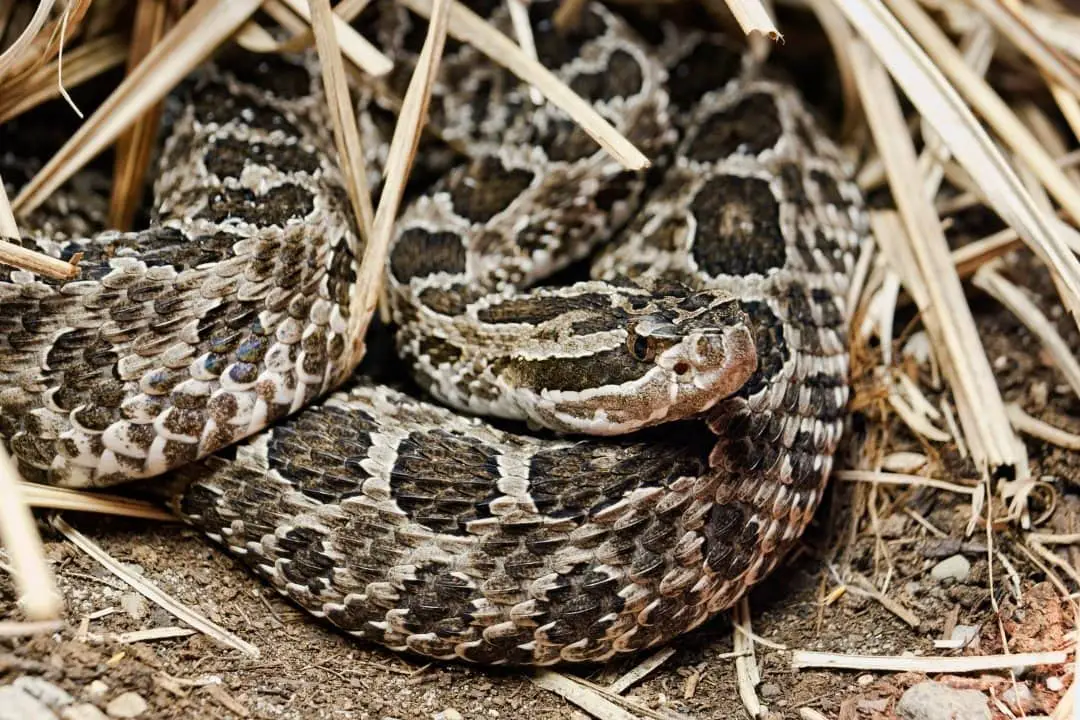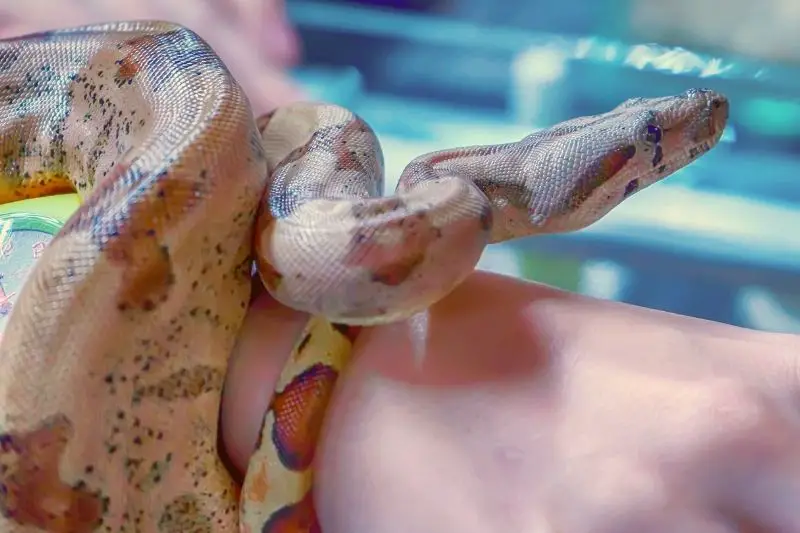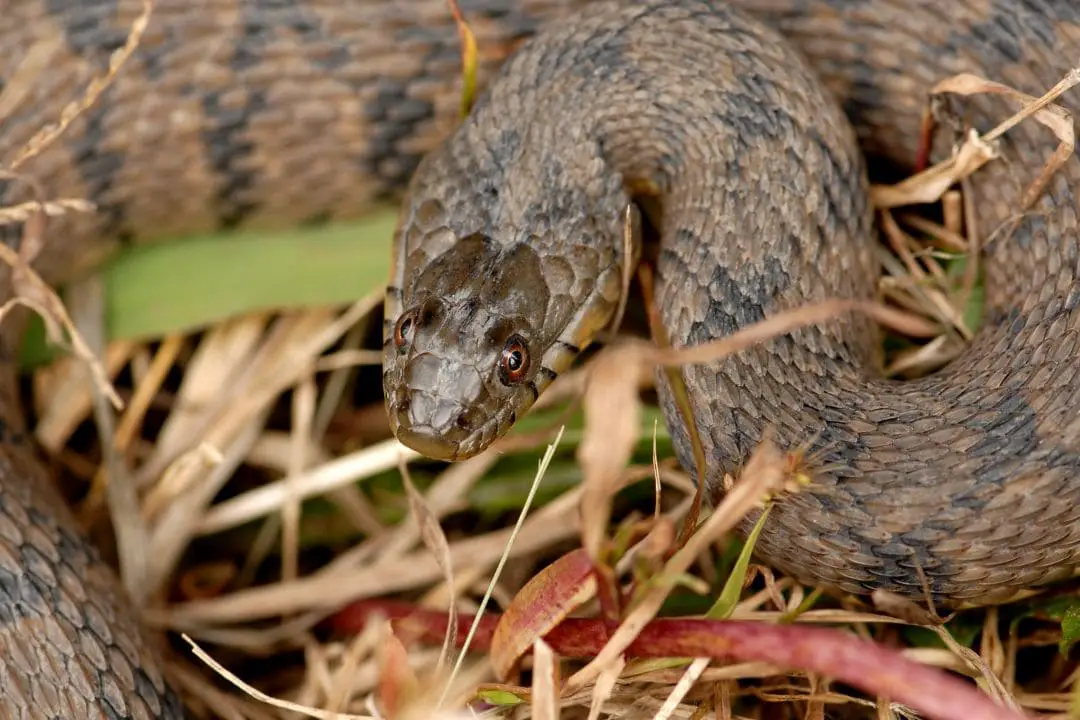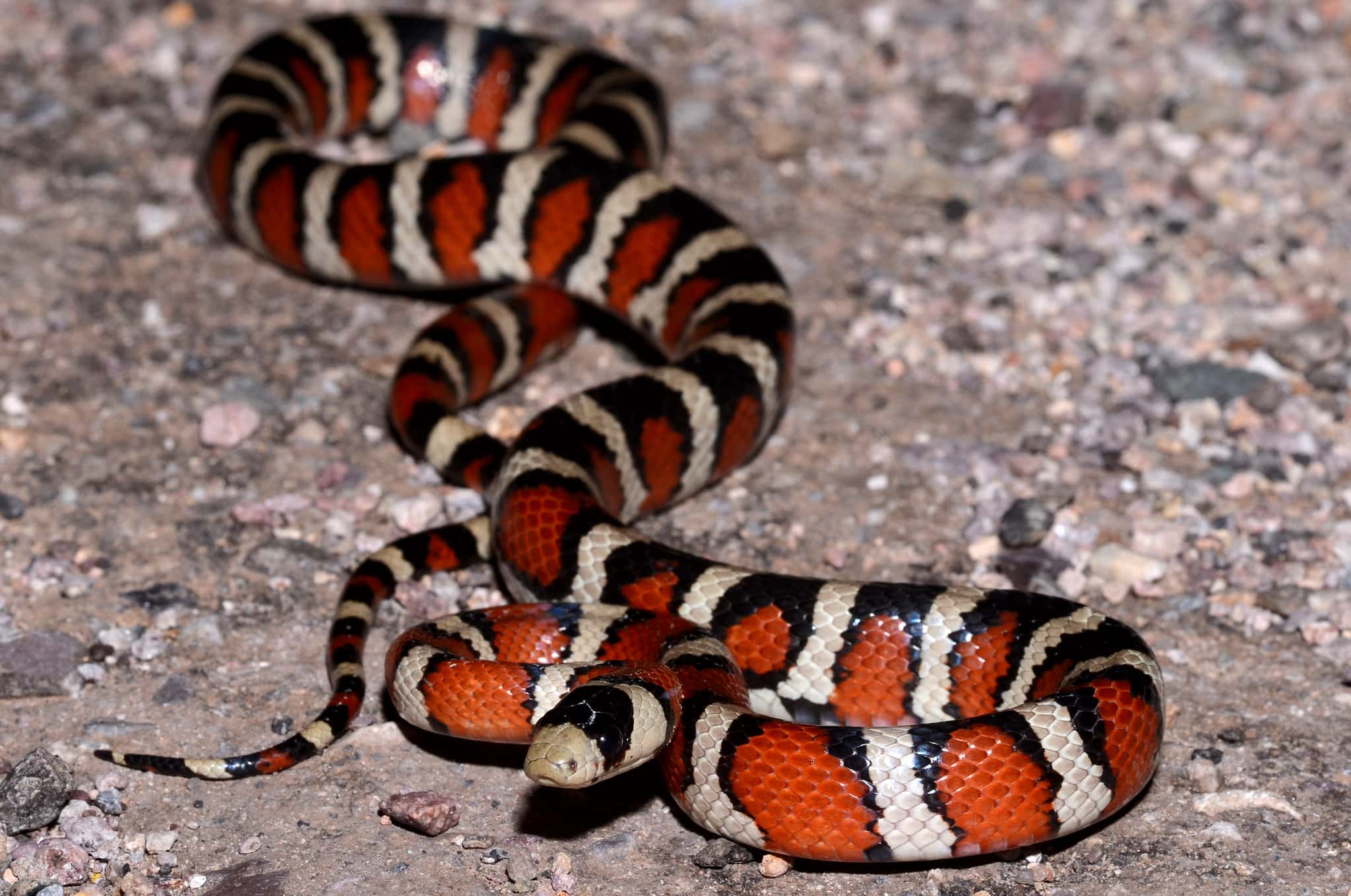The state of Michigan has a wonderful array of snakes just waiting to be discovered. A quick hike will find so many wonderful species thriving in their natural habitats.
This state is outstanding for herping, especially since it has only one native venomous species. Here, we’ll look specifically at the snake species of this region. Let’s go.
Kirtland’s snake (Clonophis kirtlandii)
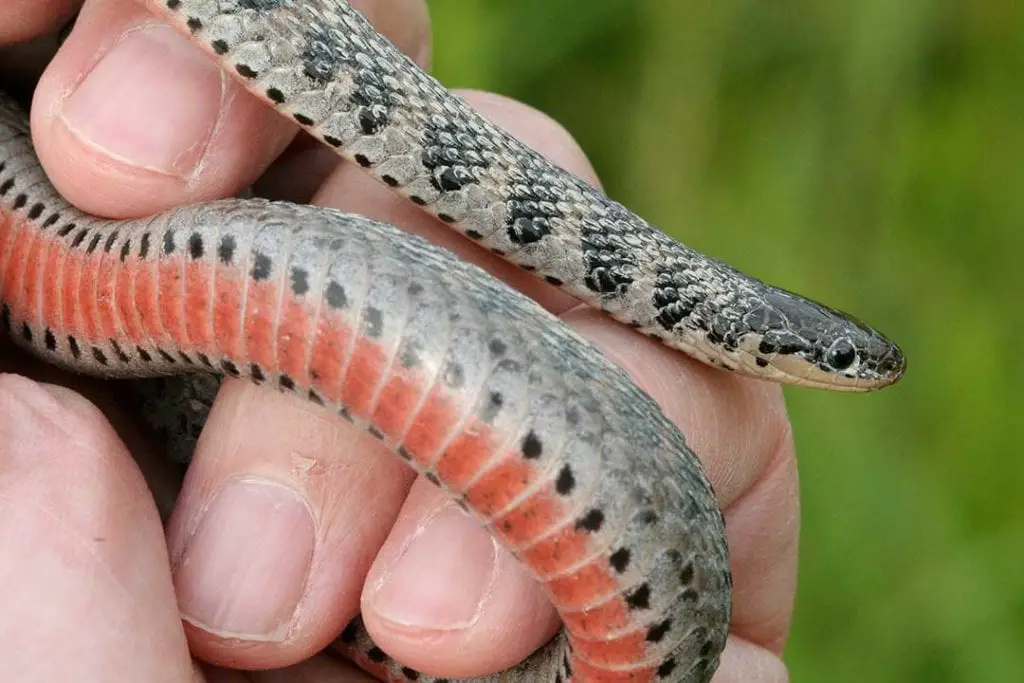
The only species in the genus Clonophis, the Kirtland’s snake is an endangered species that primarily eats slugs, earthworms, and small reptiles and amphibians.
In the entire observed history of this species, the Kirtland’s snake has never bitten a human being (nor any pets that can be found on record).
Entirely harmless and non-venomous, the Kirtland’s snake is, sadly, endangered in the state of Michigan. If you are out herping, these are easy to recognize.
Adults are approximate 1 ft to 1.5 ft long, grayish-brown and marked with small black dots on both sides of the spine, as well as on each side of the snake.
If you happen upon a Kirtland’s snake, don’t be surprised if it suddenly looks as if it’s nothing more than a husk. When frightened, these snakes are capable of becoming extremely flat to make themselves less interesting to predators.
Our advice? If you find one of these in Michigan, simply leave it alone and continue on your way.
A picture is welcome, but try not to handle it unless you are advised to do so by professionals. You will almost certainly not find these around your home.
Blue Racer (Coluber constrictor foxii)
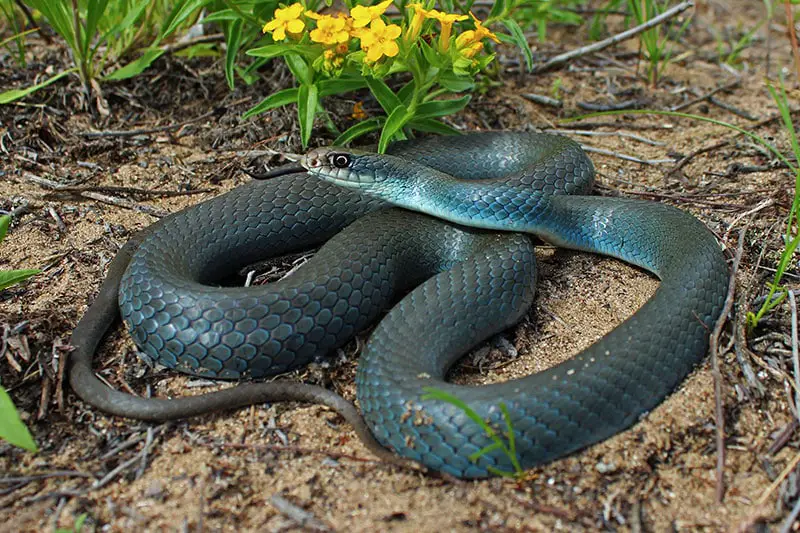
The blue racer is a beautiful black-blue snake of 4 to 6 ft at adult length.
Blue racers desperately prefer to be left alone and will actively leave long-term habitation of sites that are beginning to fill with humans, such as subdivisions that are recently built.
Though these may appear in your yard if you live in the country or in your path if you are out on the trail, don’t be worried; they’re completely harmless and non-venomous.
At worst, they may rise up and strike at you to defend themselves if completely cornered.
The solution? Don’t corner or snatch at these snakes. They only want to be left alone to continue ridding the world of small mammals (such as mice), injured birds, and other small animals that can fit in their mouths.
These snakes are not capable of harming you or your family members, though they may sneak into chicken coops and steal an egg or two if the eggs are small enough.
If this happens, gently remove the snake and place it in a grassy area far from the side of the road. The snake will leave once its broken down the eggs a bit. Snake fence can be used to prevent blue racers from reappearing in your coop.
Like the Kirtland’s, blue racers are endangered in Canada and considered a species of concern in Wisconsin.
Though Michigan does not have a ruling at the moment, it is expected that the blue racer will be considered a species of concern, threatened, vulnerable, or endangered very soon.
Northern ringnecked snake (Diadophis punctatus edwardsii)
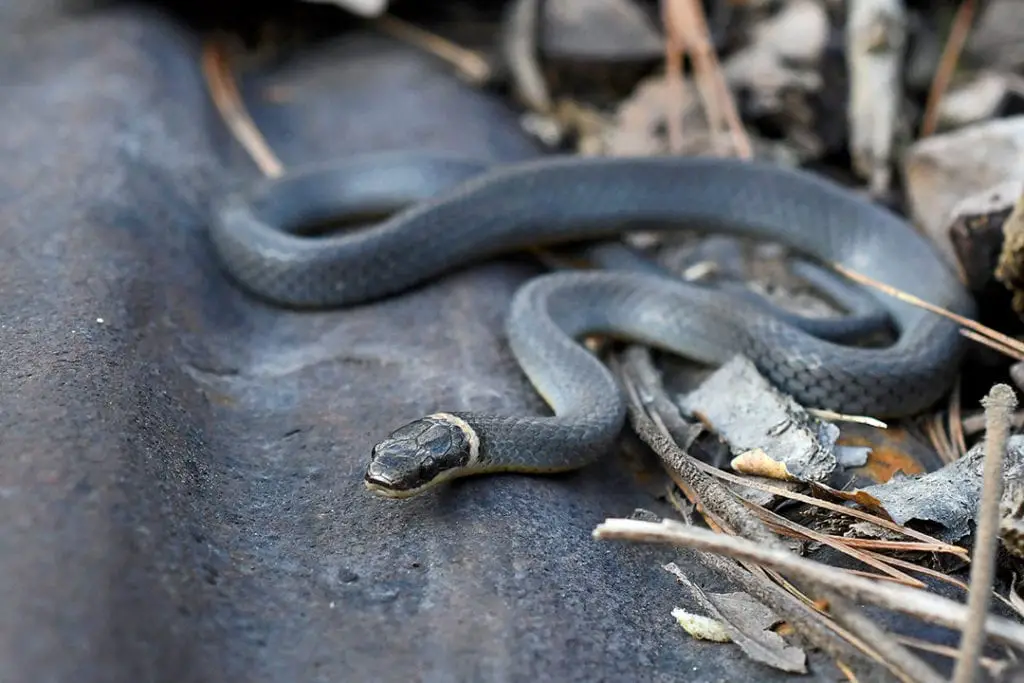
The northern ringnecked snake is a small, voracious eater who could care less if it lives right under your feet or in a pasture.
Northern ringnecked snakes are incredibly social and show little fear of humans beyond the typical snake nature of being asked to be left alone.
This does not mean that the species should be bothered, treated as a pet, or otherwise harassed, but should you see one on your hike, feel free to take a picture from a distance. The northern ringnecked snake won’t mind.
You can easily identify this snake by the yellow to orange band around the dark neck of the snake. They are approximately 1 to 2 ft long, though they rarely reach the upper end of that even as elder adults.
So friendly are these snakes that they will share nesting sites, overwintering sites, and the homes of humans they decide to adopt as well.
If you see one near your dwelling and cannot cope with the idea of a snake in or around your house, simply relocate it to a nearby wooded area, especially if it has a good deal of fallen logs and leaf litter (which they prefer).
This species is entirely non-venomous and poses no threat to humans, pets, children, or anyone else. Unless you are a salamander, which are some of their favorite foods.
Eastern Fox Snake (Pantherophis gloydi)

The eastern fox snake is a threatened species in Michigan. This small non-venomous snake enjoys mice, very tiny rats, rodent or insect pests and small birds.
If you see one around your property, be aware that it is helping weed out your pests; not threatening you or your pets.
These snakes have lost atrocious amounts of their habitat to human progress and climate change throughout the years, putting them at a high risk of becoming endangered in the very near future (and likely progressing to being extinct if these issues are not further controlled).
Unfortunately, the eastern fox snake can often be seen copying cousins like the cornsnake and gray rat snakes and rattling their tails aggressively to ward off predators.
This sadly makes for quick misunderstandings and poor identification when humans attempt to protect themselves, pets, children, or their property by killing eastern fox snakes.
The best way to tell this species apart from venomous snakes (there is only one venomous snake in Michigan, we’re getting to it, and it looks nothing like this one) is by glancing at the eyes. In Michigan, the single venomous snake has cat-slit eyes.
The head is also blunter (and, as I lovingly put it, reminds me of a Boston Terrier) instead of long and pointed.
While we realize that, in an emergency event, you are unlikely to stop and look at the eyes of a snake, be aware that studying a few pictures will quickly make it easy to recognize the difference between the eastern fox snake and the venomous snake that dwells in Michigan.
Pantherophis vulpinus, the very close cousin of P. gloydi, is not considered to be threatened but may end up on the same list as P. gloydi in the end.
The western fox snake is very similar, you can tell them apart by the number of blotches, where the western fox snake has 41 blotches the eastern for snake found in Michigan has 34.
Eastern Hognose Snake (Heterodon Platyrhinos)
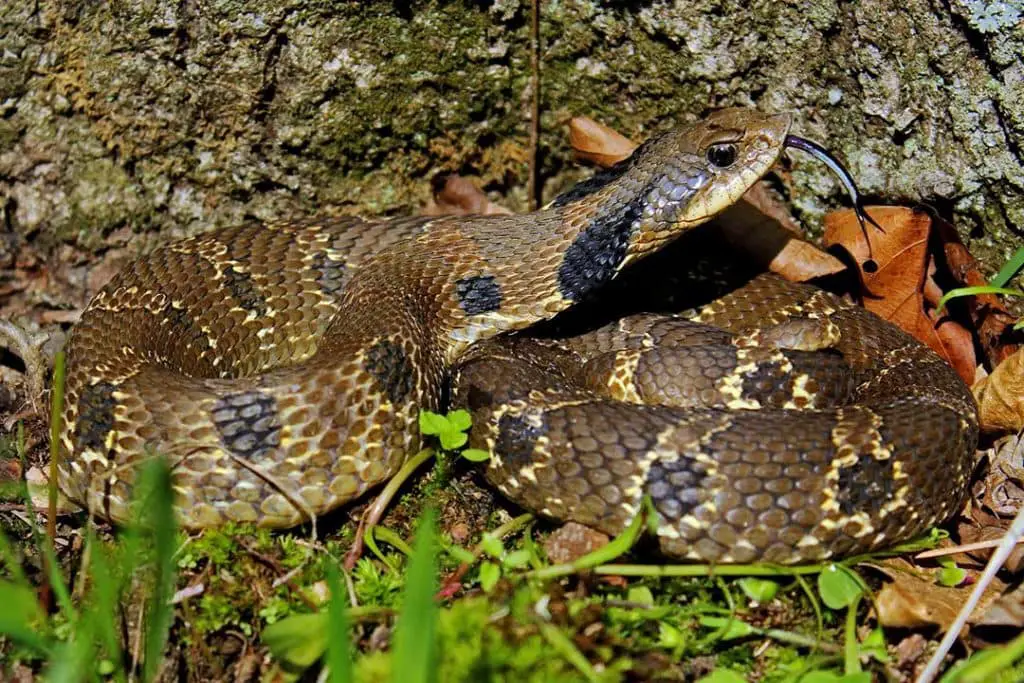
The famous eastern hognose snake! You have likely seen hognose snakes at zoos, in homes, or at reptile shows.
Easily found in the pet trade and throughout the United States as display animals, the eastern hognose snake may be one of the most often-kept venomous snakes in the country.
Now, these are incredibly mildly venomous and they are rear-fanged, which means that we’re considering them to be non-dangerous and, essentially, non-venomous.
The bite is almost impossible to get unless you shove your hands in the snake’s mouth (due to the shape of their head) and… friends, you really have to try to get this snake’s fangs in you. We’re talking frat party level trying, okay?
Perfectly safe for captive bred to be handled by children, if bitten the result is usually no worse than a bee sting (though, as with bee stings, some very rare individuals may need further medical treatment for anaphylactic shock.
These account for less than 100 people per year around the entire country). These happy, silly snakes are the pride and joy of many keepers and come in an enormous array of colors.
In the wild, they are often colored to better blend in with their surroundings. They are found simply all over the place, but especially in Michigan.
Rather than chase a human or attempt to attack, these snakes are more likely to roll over and show their belly to the world, much as an opossum would to oncoming traffic.
They may also musk, which makes them smell as if they’ve been dead for several days and tends to repel predators (and us).
They may also take on the same appearance as one of our earlier discoveries up above and become as flat as they possibly can be. Some very intimidating individuals may even puff up like a cobra (!) and spit or hiss.
Very scary, little friend. We’ll take a hundred of you.
This species enjoys primarily toads and may eat a mouse here and there. If you are overrun with toads and see hognose in your yard, be excited: help is on the way.
There are no documented human fatalities related to this species. If you desire to take care of one of these snakes, please get one from a reputable breeder and do not remove them from the wild. Thank you.
Eastern Milk Snake (Lampropeltis triangulum triangulum)
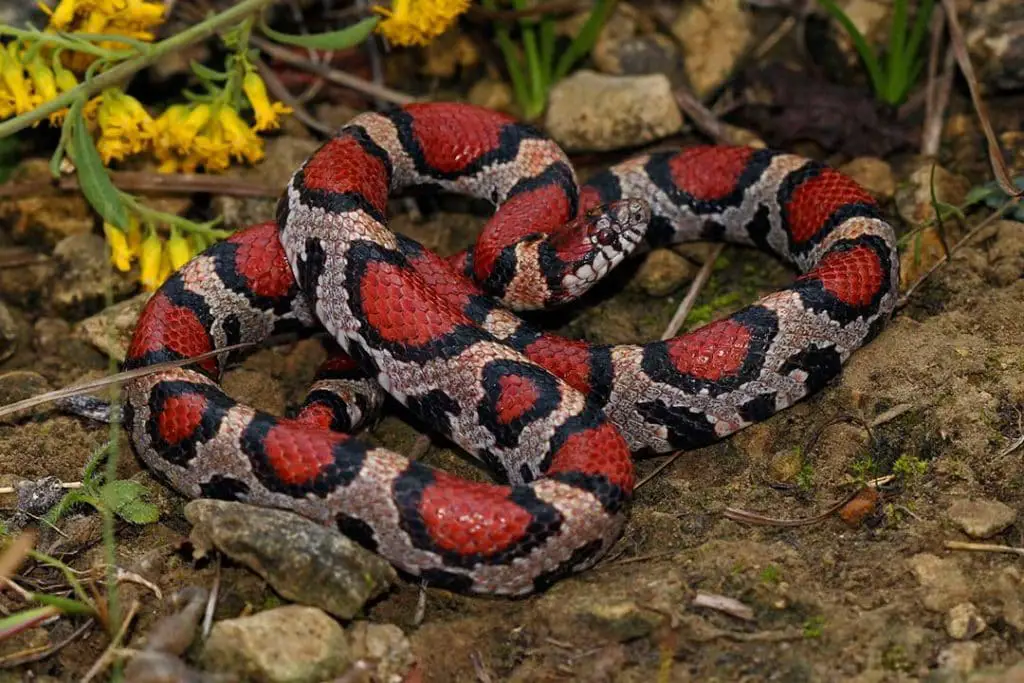
That’s right, two triangulums! The eastern milk snake is a quiet, medium-small snake that preys primarily on small reptiles, amphibians, and mammals and is an opportunistic feeder that adores dinner time.
Often mistaken for Miami morph cornsnakes, the eastern milk snake has little to do with that genus. They share a family (colubridae), but that’s it.
These snakes are entirely non-venomous and kill their prey via crushing. However, at only 2 to 4 ft long, they won’t be able to do any harm to you or your family.
These are a least concern snake and found quite frequently both around human dwellings and out in the wild. Their vivid patterning and colors make them an easy snake to spot if out herping.
Smooth Green Snake (Liochlorophis vernalis)
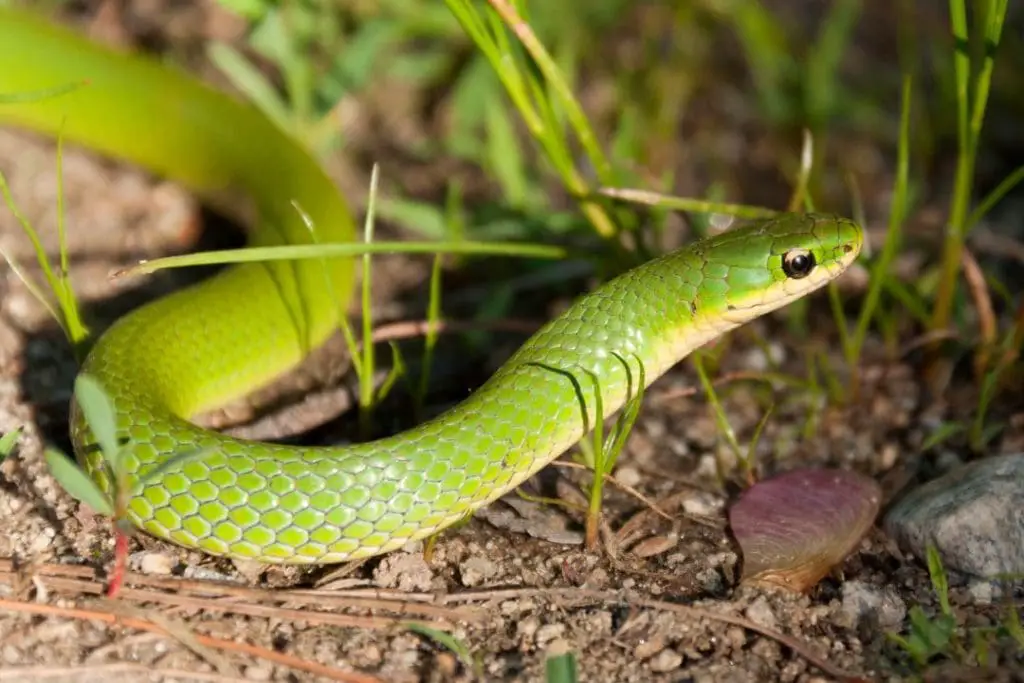
The smooth green snake is another small species that, at adulthood, should be less than 2 ft long and tends to have a slender build throughout its life.
Snakelets are usually a dull olive color that help them hide from predators since they are entirely non-venomous and not a threat to anything other than crickets.
These tiny smooth green snakes are insectivores and eat only insects that they encounter.
This, of course, means that spraying bug killer in your area is likely to harm these snakes. If you want good natural protection from pests, few species are better than L. vernalis.
Unfortunately, they are only active from April until October in Michigan (and surrounding states) due to their need for warmer weather. Finding these snakes in the wild during any other season (such as when herping) will likely lead to their death if they are spooked into fleeing their home.
Please be cautious if your goal is to find them and be aware of how sensitive they are to the cold.
Though these snakes rarely bite, if at all possible, snap only a picture of them and leave them alone when encountered.
As handsome as they are at adulthood with their vivid green scales, they are also very delicate and break easily.
Copper-Bellied Snake (Nerodia erythrogaster neglecta)
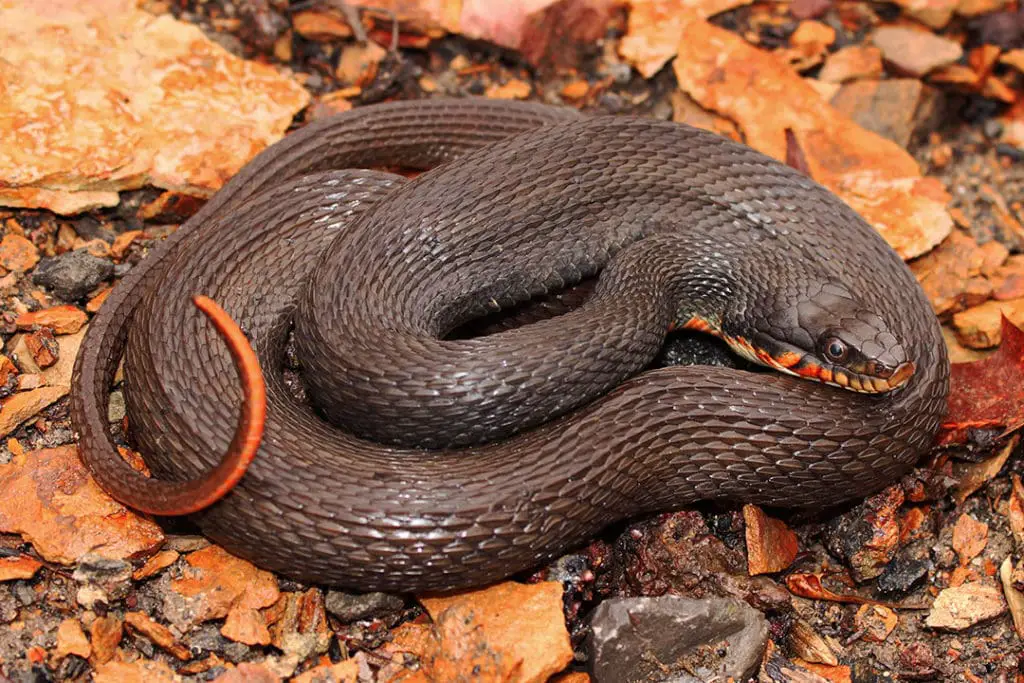
The copperbelly (or copperbellied water snake) is incredibly rare in the Michigan area and, in all honesty, throughout most of its indigenous range.
This is due to human progression and climate change absolutely destroying their native habitat and overcollection for the pet trade.
This is incredibly unfortunate since this harmless non-venomous snake is exceptionally good at providing pest control and is a real stunner.
If seen in the wild, please avoid them as much as you possibly can. It is illegal to collect them for the pet trade and incredibly damaging to the remainder of those few left in the wild.
Though programs are pushing to help this species, they are truly not in a good way as of this writing. Most wild populations are now extinct.
If you find one in the wild, contact your local natural resources/wildlife center and, if you are an active herper, ask if they would like reports if you find more.
Many are keeping strict track of them when they appear, where, and what shape they are in.
This is not encouragement to go out and find them, but rather a notice that if you see one, get general information and see if the local DNR is interested in the report.
Common Water Snake (Nerodia Sipedon)
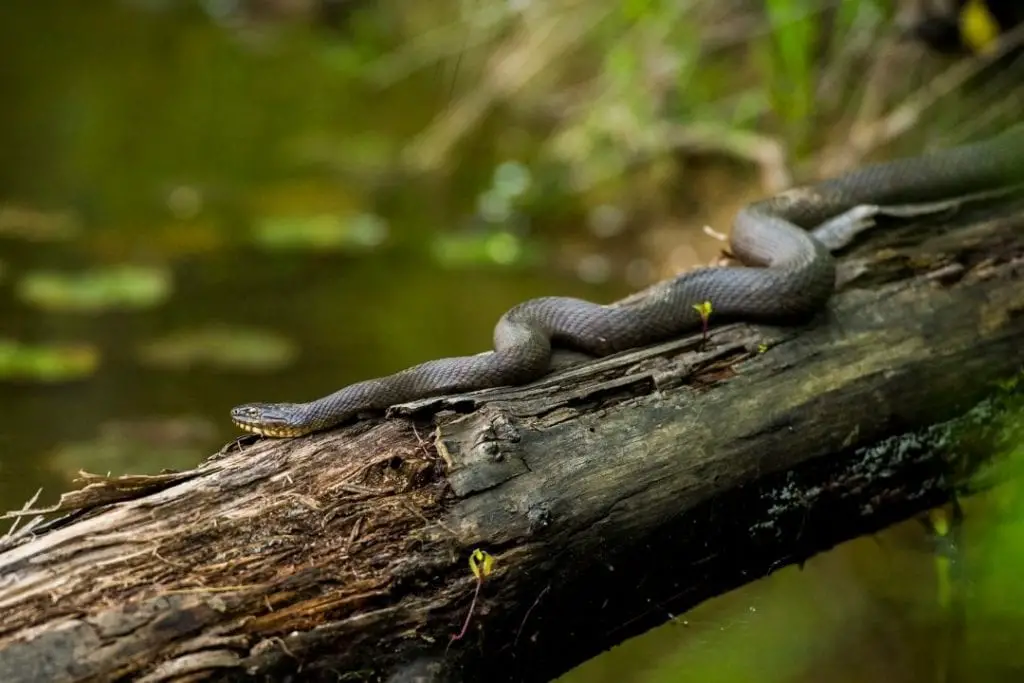
The common water snake suffers from one enormous problem and that is that it looks incredibly similar to the cottonmouth upon first glance.
Heads up! If you are in Michigan, the cottonmouth does not exist in this state. There have been no sightings of cottonmouths and no bites whatsoever.
Unless the species immigrates in that direction in upcoming years, you are not dealing with a cottonmouth. You are dealing with a grumpy common watersnake and it is entirely harmless.
These nonvenomous beauties are very aggressive if picked up or otherwise disturbed, adding to the confusion between them and cottonmouths.
Worse, their saliva contains a very mild anticoagulant that will make a bite bleed quite profusely. Will they bite you or your family?
Absolutely; if you bother them. If allowed to leave peacefully, most will take the chance to run.
Black Rat Snake (Pantherophis obsoletus)
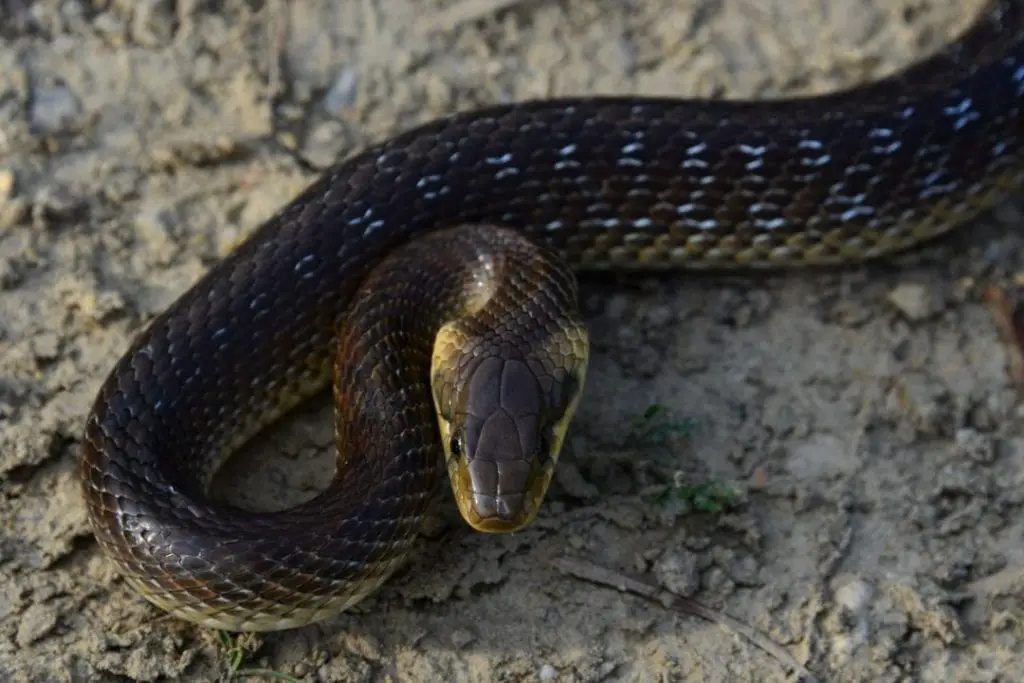
The black rat snake is one of the most common snakes in Michigan and is frequently found in hen houses, corn silos, and anywhere that they may find prey.
These snakes have a record length of 8 ft but are more commonly sized in 5 to 6 ft as adults. There is no risk to dealing with black rat snakes or having them around unless, for instance, you have prized pet gerbils or hamsters.
Completely harmless, non-venomous, and happy to just hang out, the black rat snake is one of the most common beginner snakes in the pet trade and should only be purchased as a captive bred species to better protect the wild population.
As identified throughout this list, several species have been over-captured and the black rat snake breeds easily in captivity. There is no reason to collect these snakes in the wild any longer unless for specific scientific ventures backed by a University or government necessity.
If you happen to run into one of these snakes in the wild, feel free to move it from your path if need be. Though they may bite, the attack is usually no worse than a bad scratch and rather laughable.
We do not recommend touching them if at all possible but, should you find one on a roadway, we would rather the snake be gently nudged off of it than run over. Experienced herpers likely already have this policy.
Gray Ratsnake (Pantherophis spiloides)
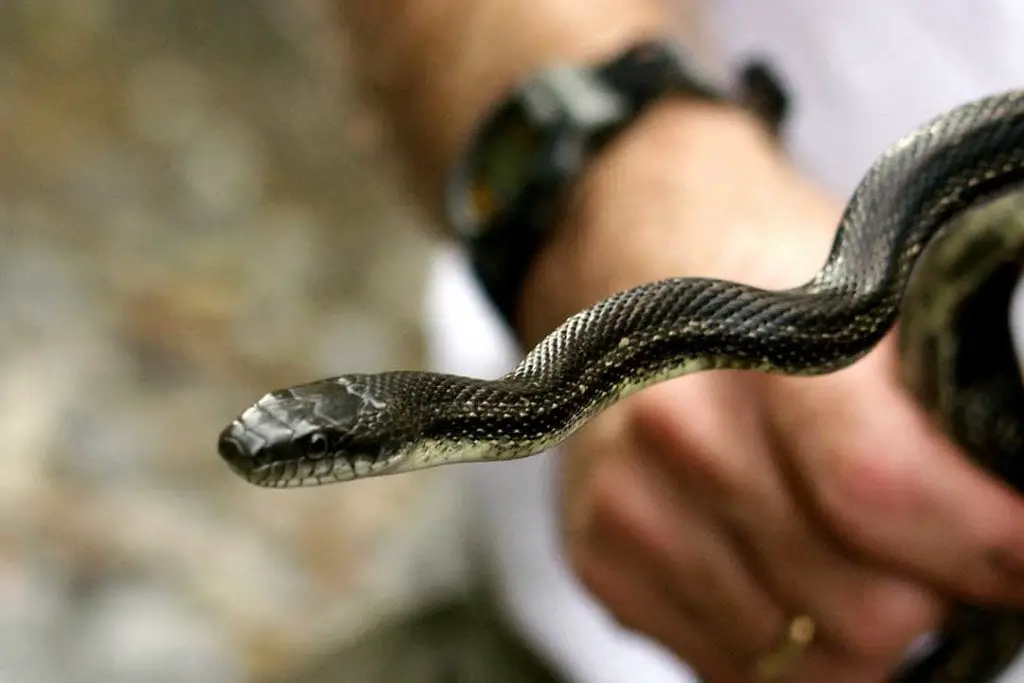
Much like the black rat snake, this species is a specific species all on its own but really only differs, for the vast majority of the public, due to its color and range.
You may refer to the black rat snake entry above this for further information as the two species are very, very close.
The sole difference is that the gray rat snake is slightly less likely to strike should you come upon it, but may still go for you if feeling very threatened.
Queen Snake (Regina septemvittata)

The queen snake, also frequently called the banded watersnake, prefers a wet area ideally with a stream or a river through it. You’ll also see them near large lakes and, sometimes, in freshwater inlets near oceans (obviously not within Michigan).
Frequent eaters of freshly-molted crayfish, small fish, and amphibians, this species of snake is of no threat to humanity or any pets whatsoever.
Unless you are hiking in a very wet area, there is a good chance you won’t see this snake at all.
Though beautiful and shy, queen snakes are also very good at disappearing into the undergrowth and fully escaping from humans intent on interacting (which we strongly recommend against) or taking photographs of them.
Dekay’s Brown Snake (Storeria Dekayi)
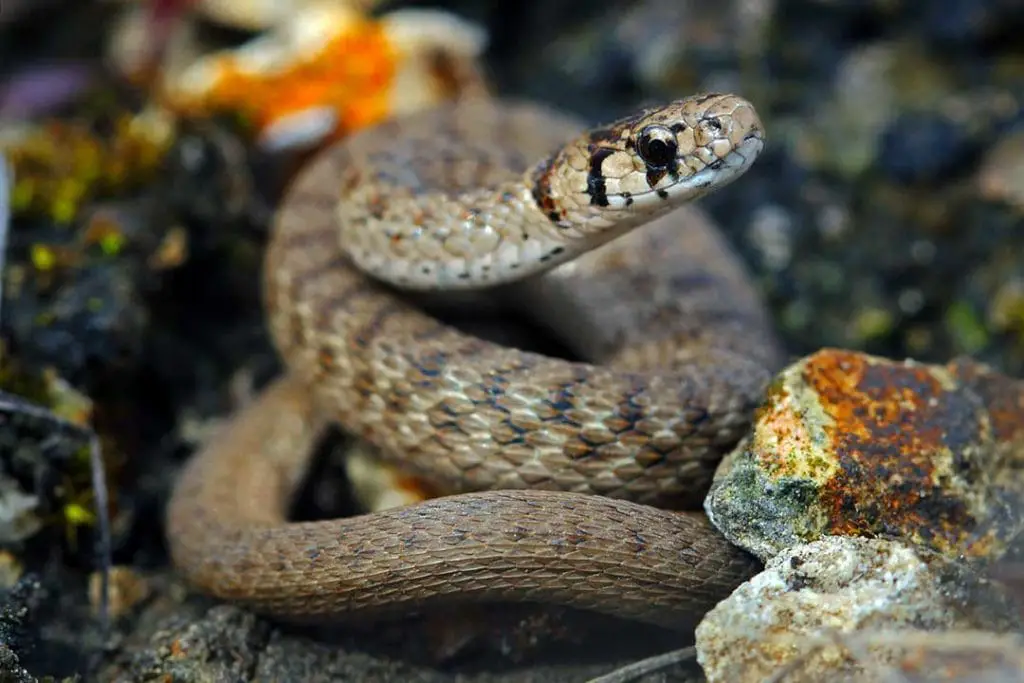
The De Kay’s brown snake, which we will shorten to ‘brown snake’ throughout the rest of this snippet, is nothing like the Australian brown snake, which you may have heard of.
This brown snake is completely harmless, non-venomous, and extremely small. Most adults are less than 1 ft in length, or smaller than your average school ruler.
Brown snakes primarily subsist on earthworms, slugs, and snails. This neat little snake can remove snails from their shells with the use of evolved prey-specific jaws and seem to treat snails as especially exciting food.
Rarely kept in captivity, this snake is a common sight everywhere throughout a great deal of North and Central America, and is of least concern.
This does not mean they should be collected (and should not be handled if at all possible when encountered in the wild).
Honestly, they are often mistaken for very large earthworms or “nightcrawlers” and few people notice the “worm” they’re holding actually has a snake’s head and a little tongue flicking toward them curiously.
Northern RedBellied Snake (Storeria occipitomaculata occipitomaculata)
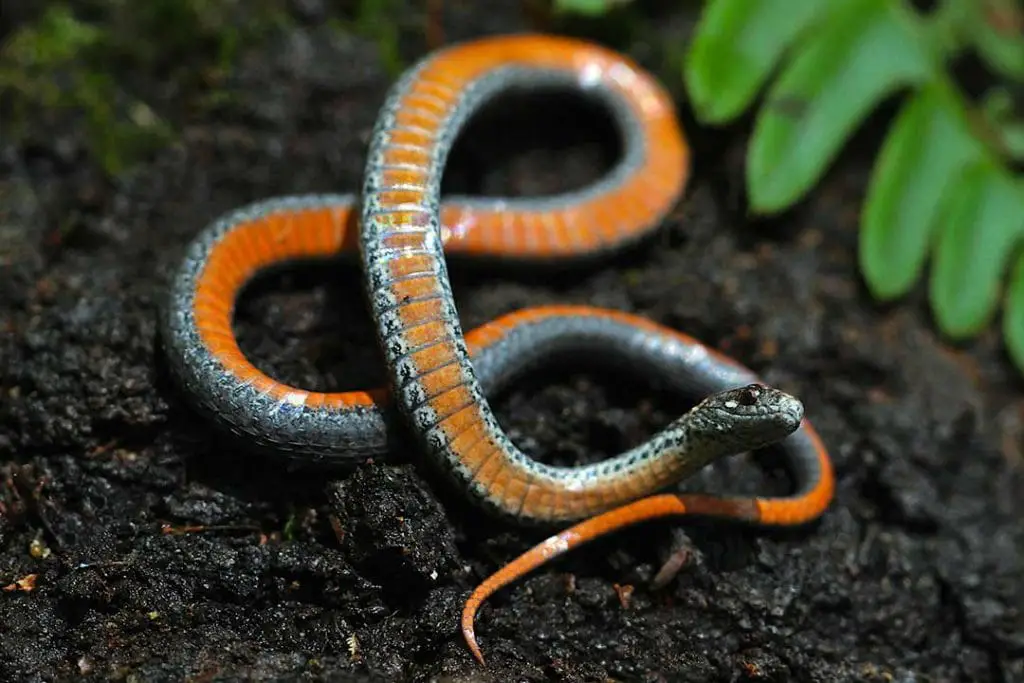
The northern redbelly snake is a, all professionalism aside, very rude snake. They are easy to hold even when wild born, but will often musk extremely aggressively all over anyone who touches them.
If you need to handle one, grab a pair of gloves first to save yourself from the smell.
That said, they are otherwise unlikely to bite or do anything particularly worrisome if they do need to be handled. They are a very attractive snake and look quite a bit like the copperbelly described above, with a red belly and a dark overside.
They are only 1 ft long or so as adults but the smell they are capable of creating is a thousand times that in magnitude and, really, quite impressive.
These little snakes may or may not be striped, and may or may not have a few black dots on their heads depending strongly on their exact location in which they are found. Again, this is not a species that is regularly kept in the pet trade nor should it be captured in the wild for pet use.
Leave wild animals in the wild unless otherwise assisted and encouraged to do so by authority figures.
Butler’s Garter Snake (Thamnophis Butleri)
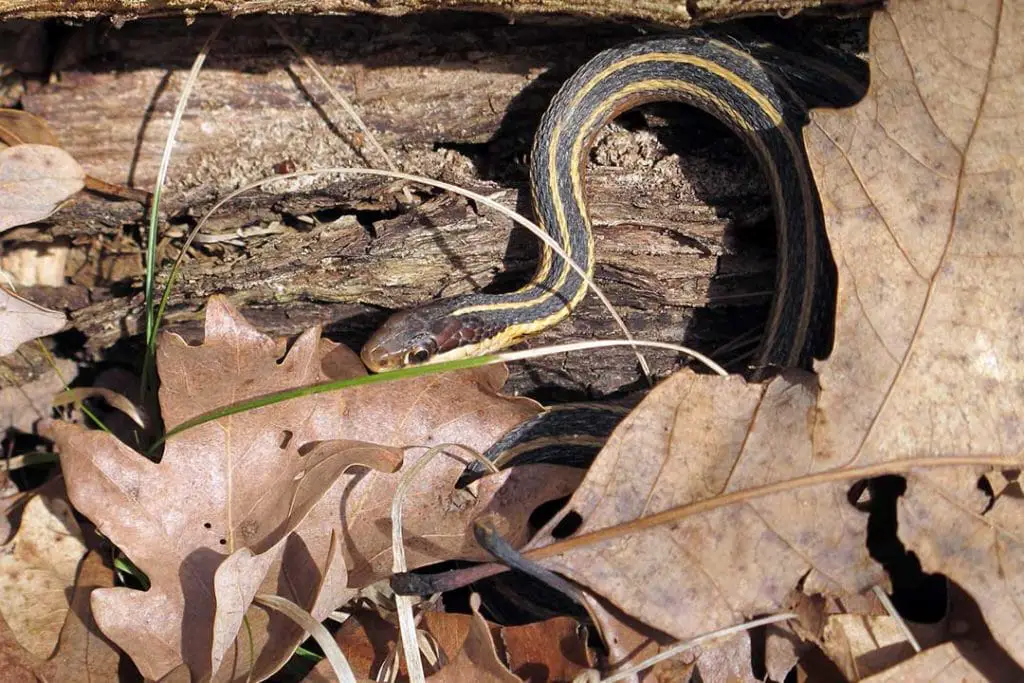
Butler’s garter snake is an easily recognized garter snake with its orange to yellow trio of stripes down the length of an otherwise brown-black body. These are another small species of snake rarely reaching 2 ft in length at adulthood.
Though listed as endangered in other nearby areas, it is not recognized as a species of concern within Michigan. Still, we don’t recommend collecting these for keeping in captivity as they are often very frantic to escape.
They aren’t very good at it, most just wiggling in place tantilizingly for the predator that wants to eat them, but the stress means that they usually do not deal with the swap from wild to captive very well.
This is one of only two garter snake species in Michigan, the other appearing very similar but for the fact that the Butler’s has a very tiny head in comparison to the other, which we will cover in the next listing.
Eastern Garter Snake (Thamnophis Sirtalis)
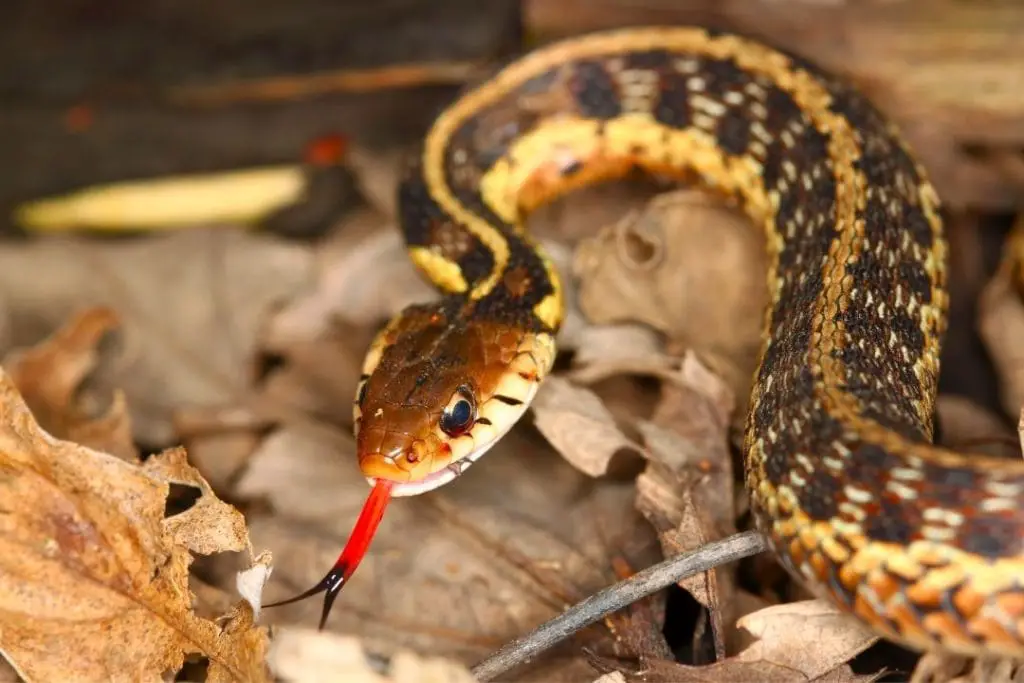
The eastern garter snake appears very similar to the Butler’s, though with a larger head, but this particular garter tends to get a great deal larger than their cousin.
Coming in at 2 to 4 ft in length, only juveniles and small specimen can possibly be confused between the two species. Adults will look nothing alike despite similar patterning and coloration, simply because of size difference.
All garter snakes, much like hognose, are very mildly venomous but this venom almost never bothers human beings or pets. Again, at most, it is similar to a bee sting and a bee sting reaction.
Though this does not mean that you will be allergic to the venom if you are allergic to bees, so keep that in mind.
Northern Ribbon Snake (Thamnophis sauritus septentrionalis)
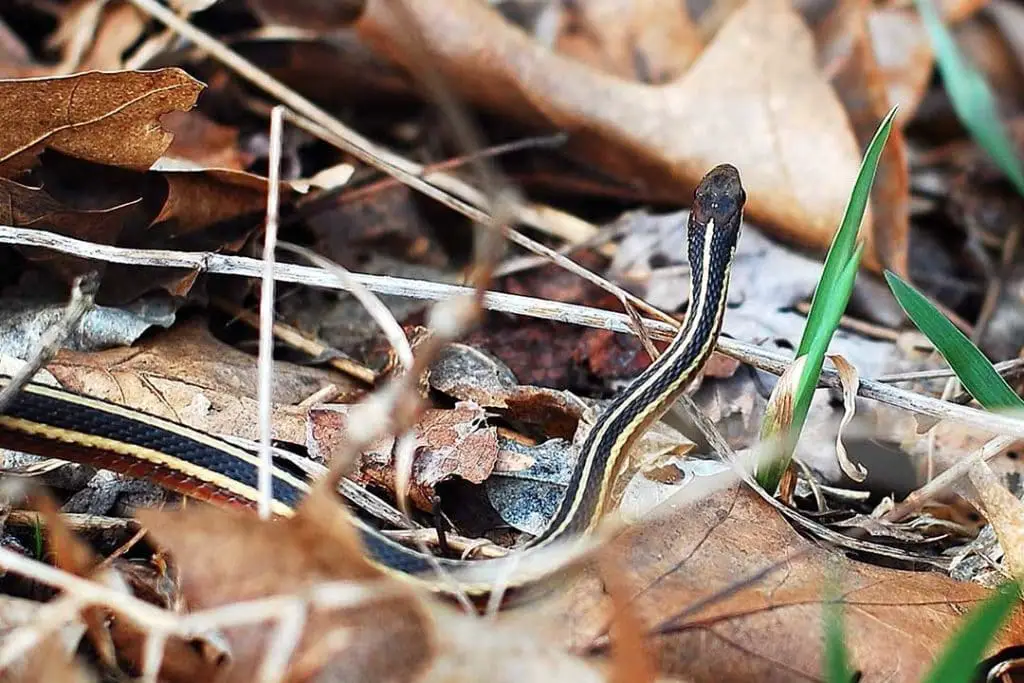
Our final non-venomous friend is the northern ribbon snake. Like all garter snakes, of which this is one, it is often found in marshy areas and enjoys fish, amphibians, and other wetland-dwelling creatures small enough for it to eat.
Ribbon snakes are of no potential harm to you or your family, though they should be left alone if at all possible due to their ability to musk you straight into a shower.
As well, all garter snakes give birth to live young which can care for themselves immediately. If you see a very tiny garter or ribbon snake, leave it alone. It will get by just fine.
Eatern Massasauga RattleSnake (Sistrurus catenatus catenatus)
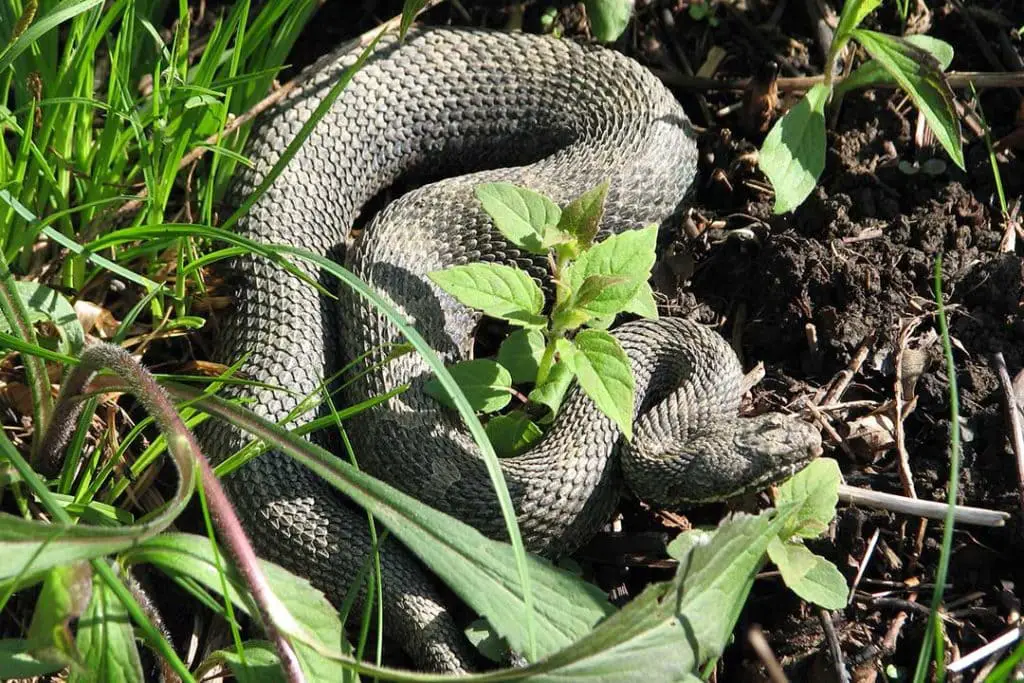
The eastern massasauga rattlesnake is the one and only venomous species in Michigan as of this writing.
Though we recognize that with climate change, other venomous species may migrate north for the moment, this is the sole venomous snake residing in the state.
The only state this particular snake resides in upon which it is not considered endangered is, indeed, Michigan, where the species is of “special concern”.
Yes, that means you cannot kill this species unless you are in serious danger from it and you had better have a very good excuse if the authorities find out.
Very few people have ever died from bites from eastern massasauga rattlesnakes and all of them on record have died due to a lack of care in hospitals.
Bites are rare, and sightings of this snake are rare as well. Unless you step on them or put them in a corner, the only venomous snake in Michigan will not harm you.
Frequently Asked Questions

Resources
CLARK, Hubert Lyman. The water snakes of southern Michigan. The American Naturalist, 1903, vol. 37, no 433, p. 1-23.
CARPENTER, Charles C. A study of hibernacula and hibernating associations of snakes and amphibians in Michigan. Ecology, 1953, vol. 34, no 1, p. 74-80.
Conclusion
And there you have it. All of the beautiful, wonderful, incredible snakes of Michigan in one simple list. We hope this has been informative and entertaining. Happy Herping!
